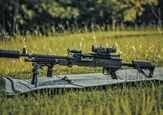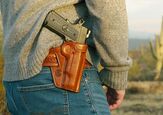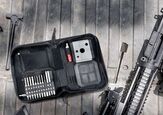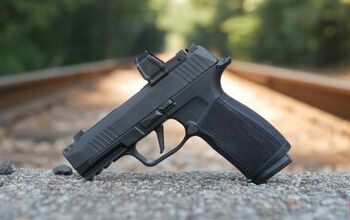TFB 1,000 Round Review: PSA Sabre 15 (Duty Grade Or Don't-y Grade?)

Palmetto State Armory is best known for being a source of affordable AR-15s. But at SHOT Show 2023, PSA unveiled the Sabre line of “duty grade” guns. They included features normally seen on high-end rifles, and PSA promised improved quality control without breaking the bank. I have had the chance to put 1,000 rounds on one of the Sabre-15 rifles, and it seems like PSA has made good on these promises.
PSA @ TFB:
- NEW Palmetto State Armory Sabre-10A1
- TFB Review: Palmetto State Armory AK-105 – An Abortive Part 1
- TFB Review: Palmetto State Armory AK-V Pistol
- [SHOT 2024] PSA Displays Wide Range Of New Guns And Prototypes
- TFB Review: Palmetto State Armory AR-15A4
Disclosures: Palmetto provided this gun for this review. I have done reviews previously for PSA, some have been good, and some have been bad. I paid for the ammo, TFB paid for the article.
Specifications:
I opted for this model of Sabre-15 for the review. I have a lot of SilencerCo suppressors, and a pinned ASR flash hider made a lot of sense for my use. Here are the published specifications from PSA:
Barrel Length: 14.5"
Gas System: Carbine-Length
Barrel Steel: Cold Hammer Forged Chrome Moly Vanadium (FN “Machine Gun Steel”)
Barrel Finish: Phosphate
Muzzle Thread: 1/2-28
Chamber: 5.56
Twist Rate: 1:7
Barrel Extension: M4
Gas Block Type: Geissele .750" Super Gas Block; Pinned to Barrel
Muzzle Device: Pin/Weld SilencerCo ASR
Receiver Material: Forged 7075 T6
Receiver Type: M4 T-Marked
Hand Guard Type: Geissele 13.5" Super Modular MK14 M-Lok Rail
Bolt Carrier Group: PSA Custom Fathers of Freedom BCG by MicroBest with Sprinco Extractor Spring
Bolt Steel: Carpenter 158
Bolt Carrier Finish: Mag-Phosphate Finish
Charging Handle: Radian Raptor LT
Trigger: Hiperfire RBT Trigger with JP Reduced Power Springs
Takedown/Pivot Pins: Battle Arms Development
Buffer: Carbine
Buffer Spring: Sprinco White
Safety: Radian Talon 45/90 Safety
Finish: Black
Furniture Color: Black
Material: Forged Aluminum
Features
This particular gun has a 14.5-inch barrel with a permanently attached SilencerCo ASR flash hider. The barrel is built for hard use and is made from FN “machine gun steel” with a chrome lining. PSA’s specs state that it has a carbine gas system, but that is incorrect. It has a mid-length gas system. The barrel has a government contour, which is thin behind the gas block, and expands to .750 at the gas block and forward.
PSA fits a Radian Talon 45/90 safety on this Sabre-15. It works fine but does not snap very crisply between positions. I would like to see this a little more crisp on a gun in this price bracket, but it is functional. I left it in the 90-degree configuration because all of my ARs are set up that way and it feels right. If you are a fan of 45-degree safeties, you can switch it around and it will operate that way.
The trigger is a Hiperfire RBT trigger with JP reduced power springs. By my trigger scale, this trigger breaks at about 4.25 pounds. It is a crisp single-stage trigger that can run quickly. My personal preference is a two-stage trigger like the Geissele SSA, but the Hiperfire is a nice trigger and fits well with this kind of carbine.
Both the stock and pistol grip are from Magpul. The SL pistol grip is a little small for my taste but is functional and has a steeper angle than classic grips like the A2 so it is easier to run in more modern shooting styles. The SL-S stock is comfortable and has two storage compartments for batteries or other small items. Those compartments are sealed with two o-rings and can be opened without removing the stock from the buffer tube or removing the butt pad. Magpul also supplies the expanded trigger guard.
There are other little details throughout that show that PSA intended this gun for hard use. The castle nut is staked in two openings so it cannot back off on its own. The staking does not end there, the two gas key screws are very heavily staked in place. Rather than taking the easy route and just using the two set screws in the Geissele gas block, PSA pinned the gas block to the barrel as well. It is not going to be dislodged by rough handling or firing schedules.
Magazine Compatibility
I always try to use a wide range of AR magazines in a review like this. It is such a ubiquitous magazine type that there are many options in the market, ranging from exceptionally good to very bad. Some guns handle all of them with little drama, others are very picky. The Sabre-15 worked with every magazine that I tested, including:
Duramag 30 steel
Duramag 30 aluminum
Hera H3 Gen 2 30
PSA PMX-AR30
ELander 30
Surefeed E2 30
KCI Polycarbonate 30
Magpul PMAG M3 30
Magpul PMAG M2 30
Magpul PMAG 40
Magpul TMAG
Amend2 Mod-C 30
Colt straight 20
Lancer 30
All fed, locked back, and dropped free 100% of the time. None exhibited excessive wobble or other worrying signs. Perhaps there are magazines out there that would cause issues in the Sabre-15, but I was unable to find them.
On The Range
I put just over 1,000 rounds on the Sabre-15, on both outdoor and indoor ranges. My shooting was a mix of accuracy testing, deliberate fire, drills, and full-on mag dumping. This is a “running and gunning” carbine, so I did as little bench shooting as possible. One of the first orders of business was a little mini-burndown to see if it held up. I shot 200 rounds as quickly as I could, and the barrel definitely put off some smoke as the oil burnt off, but everything worked.
The Geissele Mk14 handguard on this Sabre-15 gets hot quickly. It heats up much faster than the older, heavier Geissele Mk8 handguard on one of my other guns. After 30 rounds, the barrel is clearly hot but the handguard is not. After 120 rounds of rapid fire it is hard to hold due to the heat. I do not love most rail wraps or covers, but it might be warranted here.
The carbine buffer and Springco white spring worked well, but are not the smoothest recoil system. An A5 buffer system is not truly necessary but would be a nice upgrade on this kind of setup. As it stands though, the gun is controllable and easy to shoot still. I just spend a lot of time with rifle gas and rifle buffers, and I wish all ARs felt like that.
As for accessories, less is more in my book. An optic, sling, and light are the obvious additions on a gun like this, as well as a suppressor given the muzzle device. We will discuss optics later, but this gun deserves at least some magnification. For a sling, I opted for a Blue Force Gear Vickers 2-point (the TFBtv special edition tiger stripe one, for added cool points), as is my choice for almost everything except precision rifles. There are QD sling cups on the handguard and stock so it was easy to mount the sling without any extra steps. The light is a Surefire Turbo mounted on the left side of the rail.
At about 6.5 pounds empty, the Sabre-15 is a handy little rifle. It is easy to use around vehicles and barricades, and from the less-than-ideal shooting positions that the real world provides. From 0 to 500 yards, it scores hits without any undue effort. It shoots a fast Bill Drill, transitions nicely between targets, and (most importantly) it is a lot of fun.
Optics Selection
This Sabre-15 model is a do-all rifle, and it should have an optic setup that can handle any situation. I did a little shooting with a red dot, but quickly moved to more flexible optics to take advantage of the generalist nature of this carbine. I wanted magnification for longer shots, but without losing the ability to move fast up close.
I used a Brownells 1-6x24 LPVO, a March Scopes 1.5-15x42 dual focal plane optic, and a Trijicon ACOG with a piggybacked Aimpoint ACRO C-2. The LPVO is the choice de jure for this kind of gun, and it worked well, but I wanted more magnification for accuracy testing. Next up was the March 1.5-15x, which seems like a lot of scope for this gun, but actually worked very well. A higher magnification scope could work on a 14.5-inch Sabre-15, but many in that category would be too large, heavy, or incapable at low power for a gun like this. I finally moved to a 3.5X ACOG with an Aimpoint ACRO C-2 on a Partizan Solutions mount. That provided a beautiful magnified image and a lightning-fast, yet precise, red dot by simply moving my head up and down.
Out of those options, running with an ACOG and piggyback red dot felt right on this gun. A pinned 14.5 is a generalist carbine, it can do just about anything well enough to get by. While a red dot is a fine choice, it is worth having magnification on a gun like this. For me an LPVO, ACOG and dot, or red dot and magnifier would be the right way to set this gun up.
Ammunition & Accuracy Testing
I ran a wide range of ammunition through the Sabre-15 during the review. Most was 55-grain FMJ ammo (these reviews get expensive, and 1,000 rounds of match ammo is not in the cards), and all was brass cased because steel has become so hard to find. It all fed and functioned fine, but there were noticeable differences in accuracy between loads. These groups were fired from a rest off the hood of my vehicle with a 15x scope. The groups may have been slightly better if fired from a dedicated concrete shooting bench, but the setup was consistent across all groups. I measured the velocity information with a Garmin Xero C1 chronograph.
| Manufacturer | Load | Avg. Velocity | SD | ES | Group Size |
| Winchester | M193 55gr FMJ | 2980 | 31 | 96 | 3.3” |
| Winchester | M855 62gr FMJ | 2842 | 20 | 59 | 2.2” |
| PMC | M855 62gr FMJ | 2866 | 15 | 45 | 4.1” |
| PMC | Bronze 55gr FMJ (.223) | 2689 | 63 | 171 | 3.0” |
| Hornady | Frontier 55gr BTHP | 2873 | 23 | 66 | 1.8” |
| Hornady | Frontier 68gr BTHP | 2830 | 16 | 39 | 4.7” |
| Hornady | Frontier 75gr BTHP | 2658 | 13 | 36 | 2.2” |
| Handload | 77gr Matchking BTHP | 2428 | 17 | 39 | 1.6” |
| Handload | Pulled 75gr HDY BTHP | 2220 | 39 | 88 | 1.5” |
Under 2 MOA with match ammo and under 3 MOA with bulk FMJ ammo seem to be good expectations with this gun. There were a few outlier loads that the gun hated, putting up groups over 4 inches at 100 yards, but most loads were substantially better. This is completely acceptable accuracy for a chrome-lined 14.5” barrel. The 77-grain handload with the Sierra Matchking bullet shoots around 0.75-1 MOA in my accurized rifles, and around 1.5 MOA in a lightweight carbine like this is very respectable.
Suppressed Shooting
I did a lot of suppressed shooting during this review, with both the SilencerCo Specwar 556 and Velos LBP suppressors. My suppressor of choice for this gun, with its ASR mount, would be the SilencerCo Velos LBP. “LBP” stands for Low Back Pressure, and the difference in backpressure is clear compared to older suppressors. It blows noticeably less gas back into the shooter’s face. Another benefit of this suppressor design is less gas and filth getting blown back into the receiver. The gun stayed noticeably cleaner when using the Velos LBP. You can pick up a Velos LBP from Silencer Shop.
SilencerCo Velos LBP
I did some back-to-back comparisons with those cans on the gun. With Fiocchi .223 Remington ammo, the Sabre-15 ejected at around 3:30 o’clock. When I put the Specwar on the gun, the ejection pattern moved to about 2:00 o’clock. But with the Velos attached, the ejection was right around 3:00 o’clock, unless I fired very rapidly and let the gasses build up. The ejection moved up to 2:30 during rapid fire but still outperformed the older high-back pressure design. With Winchester M193 5.56 NATO ammo, the ejection pattern exhibited a similar pattern. Less back pressure is a good thing, and the Velos LBP delivers that while still cutting down on the sound signature.
Conclusion
One anecdote helps to summarize this gun. I was shooting with a group of people, and one of the guys was shooting his Daniel Defense SBR. He also had shot a Geissele Super Duty and we were comparing some of the nicer models on the market. He commented that “my Geissele carbine” felt great, and I informed him that it was actually a Palmetto State Armory gun with a Geissele handguard. He was shocked and did not believe me at first that PSA made this gun.
That is what PSA accomplished with the Sabre-15. It feels like a much more expensive gun than it is. There are some features that I would change, and a few areas where I may have made different choices were I the one setting out the specifications for the gun. But for an off-the-shelf option that can get things done without spending so-called “Gucci” money on a gun, the Sabre-15 fits the bill.
Yes, there are nicer AR-15 options on the market. You can get a slightly better trigger or a more tuned gas or buffer system. But those guns cost substantially more than something like the Sabre-15, and depending on the company, it may be a scavenger hunt to find one to buy. Palmetto’s entry into the “duty grade” space is a success. It has the right mix of upgraded features from a base model and added attention to detail without pushing the price point into an unattainable realm. Just add an optic, light, and sling, and the Sabre-15 is ready to go.
TFB is proud to partner with Silencer Shop as our preferred vendor for all of your NFA needs. Whether you are searching for a new suppressor, SBR, or trust, Silencer Shop is here to provide a seamless and fast service for your next NFA purchase. Head over to www.silencershop.com to begin your NFA journey.

AKA @fromtheguncounter on Instagram. Gun nerd, reloader, attorney, and mediocre hunter. Daniel can still be found on occasion behind the counter at a local gun store. When he is not shooting, he enjoys hiking, camping, and rappelling around Utah.
More by Daniel Y













































Comments
Join the conversation
Great review...except you show range data without saying how far away you were. I'm guessing this is at 100 yards, since you made a comment about 4" groups at 100 yards shortly after posting the table. Still, you mention earlier that it was tested out to 500 yards. Also, MOA isn't always a reliable indicator of range distance, since a lot of people use the term MOA incorrectly as if it were simply the group size at any given range.
Much better review than the normal click bate drivel..It is appreciated..Now the criticism, put a proper head space gauge and function gauge in the review, great starting point..Put a bore scope in the barrel and take a picture of the chamber/bore, throat, and crown..Lets see how smooth or rough the chamber and other barrel parts are..
Lastly, I wish gun writers would stop saying the A5 buffer system is an upgrade on this kind of setup.. The A5 buffer does nothing better in a 16" rifle set up than the standard carbine system..It was created so a 20" gas system could use a telescoping stock, while retaining the same standard buffer weight of the M16 rifle..Then it was rejected and never used..It does not increase carrier cycle length, dwell time, or do anything better than the standard carbine buffer system other than add to the buffer weight option that is not needed in the first place..